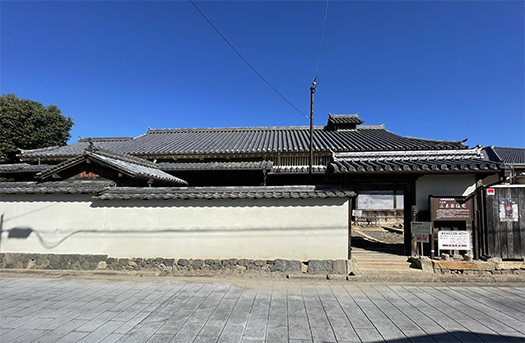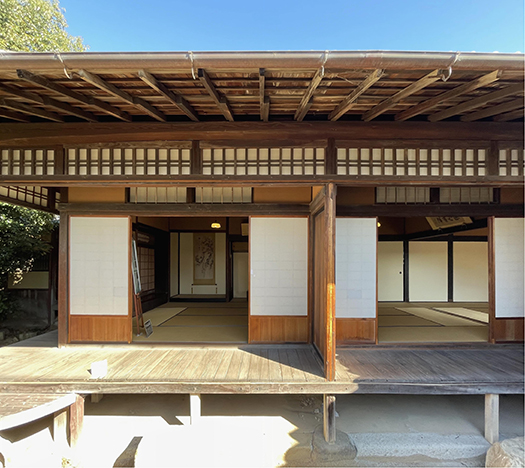

きのうの続きです。江戸期の姫路藩、播州・福崎の地域経済を中核として運営していた「庄屋・三木家」再訪篇。江戸期は「武家による政治支配」体制だけれど、それは武力支配の構造が基本ではあるけれど、一方では年貢の取り立てや管理などについては庶民階級のなかに経済掌握の機能が必要とされた。
いわゆる「庄屋層」というのが決定的に重要な役割を果たしていたのでしょう。この三木家は戦国期に英賀城に蟠踞していた武家であり、秀吉によってその武力は解体されたけれど、戦国期までの「地域支配」においては地縁・血縁などの重層的な人脈と、ムラ支配の経験知を豊富に持っていた。
地域情報の集積体として、あらたな地域領主となった姫路藩としてはそうした存在を活用することが現実的な政治経済運営方法だったのでしょう。とくに大名とか藩とかが流動的になり、幕府から「鉢植え」的に領主がひんぱんに交代させられる体制が定まって以降、こういう実質的地域支配層の重要性は高まったに違いない。
この三木家は旧英賀城にほど近い瀬戸内海沿岸地域に蟠踞していたうちの「一統」が、姫路藩の要請によって播州中部の福崎に入植してきたという家系伝承。姫路藩としては確実な経済支配体制を構築していくには、地域支配の実質を担っている庄屋層に依存することは自然な選択でしょう。
三木家ではこの地域で土木開発などの生産手段整備作業を継続的に行ってきている。
また、この家は江戸期の支配体制構築にとって不可欠であった秩序構築手段としての学問に積極的であり、歴代の当主の収集した図書類が豊富に蓄積されて、のちに日本民族学の祖といわれる柳田國男の学識を揺籃する地域最大の図書館機能を果たした。
経済と同時に知の地域センター機能までも果たしていた存在。そういう意味では江戸期の支配構造というものがきわめて集約的に表現された屋敷なのだと思っています。

こちらはいわゆる「座敷」の最高格式空間。南面する座敷には江戸期の秩序的な空間装置が表現されている。手前側は庭が展開し、外部からは築地塀で完全に仕切られている。万が一の時を考えて床の間側の壁の一部は出入り可能なように仕掛けられてもいる。実際に幕末期には一揆勢力がこの屋敷になだれ込んで、縁の一角にはそのときの「刀傷」が遺されたりしている。
現代人は住宅建築として、その機能性について江戸期までのそれとはかなり隔絶してきている。しかし江戸期の建築もそういう機能性に於いては時代にきわめて適合したものだったのだと思う。現代人はその性能とデザインということが優先されているけれど、江戸期の高級住宅は、社会的機能性について強いニーズに的確に対応したものだったのだと思えるのですね。
English version⬇
The “headman’s mansion” dominates the Edo period economy and society.
Performance and design and the essential pursuit elements of modern housing can be summarized, but on the other hand, it fits perfectly with the values that are different in the Edo period housing. ・・・・.
This is a continuation of yesterday’s article. This is a revisit to the Miki family, the headman of the Himeji clan in the Edo period, who managed the local economy of Fukusaki, Banshu, as the core of the clan. The Edo period was a system of “political rule by the warrior class,” which was based on a structure of armed rule, but on the other hand, the common people were required to take control of the economy in order to collect and manage tribute.
The so-called “headman class” must have played a decisive role. The Miki family was a warrior family coiled in Eiga Castle during the Warring States period, and although their military power was dismantled by Hideyoshi, they possessed a wealth of knowledge and experience in ruling local communities, as well as a multilayered network of personal connections through geographical and blood ties.
The Himeji clan, which became the new lord of the region as an accumulation of local information, probably found it a practical method of political and economic management to make use of such a network. In particular, the importance of such a real local ruling class must have increased after the feudal lords and clans became more fluid and the shogunate established a system in which lords were frequently replaced by “potted plants”.
The Miki family is said to have been one of the “lines” coiled along the coast of the Seto Inland Sea near the old Eiga Castle and settled in Fukusaki in central Banshu at the request of the Himeji clan. For the Himeji clan, relying on the village headmen, who were in charge of local governance, was a natural choice in order to establish a secure economic control system.
The Miki family has been continuously engaged in civil engineering development and other means of production maintenance work in this region.
The Miki family was also active in learning as a means of establishing order, which was essential to the establishment of the ruling system in the Edo period, and accumulated an abundance of books collected by successive heads of the family, which later served as the largest library in the region, where Kunio Yanagida, later considered the founder of Japanese ethnology, cradled his knowledge.
It was the largest library in the region and served as a regional center of knowledge as well as an economic center. In this sense, I believe that the mansion is a very concentrated expression of the ruling structure of the Edo period.
This is the highest-rated space of the so-called “zashiki”. The south-facing tatami room expresses the orderly spatial devices of the Edo period. On the front side, a garden unfolds and is completely separated from the outside by a Tsukiji wall. In case of emergency, a part of the wall on the alcove side has been set up so that it can be accessed. In fact, in the last days of the Tokugawa shogunate, a group of revolts swept into the house, and a “sword wound” from that time can be seen in the corner of the edge of the wall.
Today, the functionality of residential architecture has become quite different from that of the Edo period. However, I believe that the architecture of the Edo period was very much in tune with the times in terms of such functionality. Although modern people give priority to performance and design, I believe that the high-class housing of the Edo period was a precise response to the strong need for social functionality.
Posted on 10月 30th, 2023 by 三木 奎吾
Filed under: 住宅マーケティング, 歴史探訪







コメントを投稿
「※誹謗中傷や、悪意のある書き込み、営利目的などのコメントを防ぐために、投稿された全てのコメントは一時的に保留されますのでご了承ください。」
You must be logged in to post a comment.